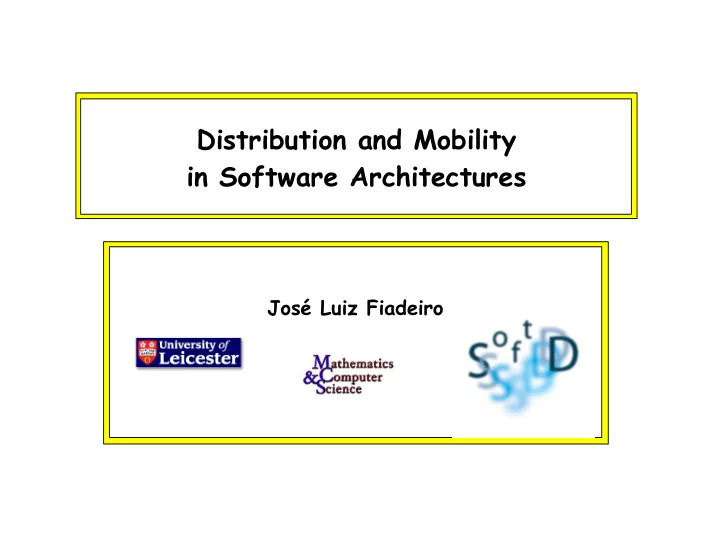

Distribution and Mobility in Software Architectures José Luiz Fiadeiro
Research Context Software Architecture —foundations —design primitives —evolution Joint work with —Antónia Lopes Mathematical Framework (Univ. Lisbon, Portugal) Category Theory —Michel Wermelinger (UNL, Portugal) —Luís Andrade Prototype Language CommUnity
Software Architecture Structural Models A B C Y Y A B X C X C A Y Components Connectors
CommUnity: Designs CommUnity designs are defined in terms of a signature — channels (input, output, private) and action names (shared,private) and actions Example . A design that models a producer design producer is out x:nat prv rd: bool do prod:[rd Æ x: Œ nat || || rd:=false] [] send:[ ÿ rd Æ rd:=true]
CommUnity: Interaction and Composition design cable is in i:nat do ac:true Æ skip x ¨ i Æ x send Æ ac ¨ ¨ rec design consumer is design producer is in x:nat out x:nat prv y: nat, rdc: bool prv rd: bool do rec:[rdc Æ y:=x || | rdc:=false] do prod:[rd Æ x: Œ nat || rd:=false] [] use:[ ÿ rdc Æ rdc:=true] [] send:[ ÿ rd Æ rd:=true] design prod-cons is out x:nat prv y:nat, rdp,rdc: bool do prod:[rdp Æ x: Œ nat || | rdp:=false] [] trans:[ ÿ rdp Ÿ rdc Æ rdp:=true || || y:=x || || rdc:=false] [] use:[ ÿ rdc Æ rdc:=true]
Motivation Abstracted —the way the components are distributed over a network —the way the connections among the nodes of the network are realized Assumed —computations are performed in fixed hosts —hosts are linked by static connections —all forms of coordination are considered to be realizable traditional distributed computing paradigm
Motivation Abstracted —the way the components are distributed over a network —the way the connections among the nodes of the network are realized Assumed —computations are performed in fixed hosts —hosts are linked by static connections —all forms of coordination are considered to be realizable Mobile computing in ad-hoc networks new forms of dist.systems
Distributon and Mobility in SA !!Architectures for Mobility !!FET/IST project, Global Computing Initiative !!!! LMU, DIPISA, DSIUF, IEI-CNR, ATX, FFCUL, IinfUW, ULEICES Goal to develop na architectural approach in which mobility aspects can be modelled explicitly as part of the application domain and mapped into to the distribution and communication topology made available at physical levels
Motivation Architecture-based approaches Distribution A B A Y Y A B X C X C C Y Computation Coordination
CommUnity with Distribution: Designs CommUnity designs are defined in terms of a signature — channels (input, output, private) and action names (shared,private) x@l g@{l 1 ,l 2 ,...} — location variables (input, output) Position where the value is available and local actions enabling condition g@l [D(g)]: G(g) Æ R(g) Position where code is executed state changes write frame
CommUnity with Distribution: Designs Example . A design that models a producer — a centralised system that does not control its own movement design producer is inloclp out x@lp:nat prv rd@lp: bool do prod@lp:[rd Æ x: Œ nat || || rd:=false] [] send@lp:[ ÿ rd Æ rd:=true]
CommUnity with Distribution: Designs Another example . A design that models a distributed system that partially controls its own movement design prod-cons is inloc lp outloc lc out x@lp:nat prv y@lc:nat, rdp@lp,rdc@lc: bool do prod@lp:[rdp Æ x: Œ nat || || rdp:=false] [] trans@lp:[ ÿ rdp Æ rdp:=true] @lc:[rdc Æ y:=x || || rdc:=false] [] move@lc:[ ÿ rdc Æ lc:=nattoloc(y) || || rdc:=true] Self-inflicted mobility
CommUnity with Distribution: Externalisation of Superposed Behaviour o externalisation of communication prod-cons sync producer consumer externalisation of distribution and mobility sync mov producer consumer’
CommUnity with Distribution: Externalisation of Distribution o consumer externalisation of distribution and mobility mov consumer’ design cable is inloc l in i:nat do ac:true Æ skip design consumer’ is design mov is lr ¨ l Æ l inloc lr outloc l in x y ¨ i Æ y in y@l:nat, out y@lr:nat prv rd@l: bool rec Æ ac ¨ action do rec@lr:[true Æ y:=x] do action@l:[rd Æ rd:=false] [] move@l:[ ÿ rd Æ l:=nattoloc(y) || rd:=true]
Conclusions Architectural techniques based on the separation of computation and l coordination can be applied to mobile systems; Distribution and Mobility patterns can be explicitly represented l within architectural models through distribution connectors; Distribution Connectors can also be used for modelling new forms of l coordination that have emerged in mobile computing — coordination styles that are location-dependent Transient Interaction — coordination styles that involve the management of the locations of the coordinated parties Remote Evaluation
Future Work Abstract a General Mathematical Characterisation of the properties l underlying Distributed CommUnity, in order to make these ideas available to other formalisms and development platforms Extend with the new distribution dimension the coordination l technologies developed by ATX for managing system evolution
Recommend
More recommend